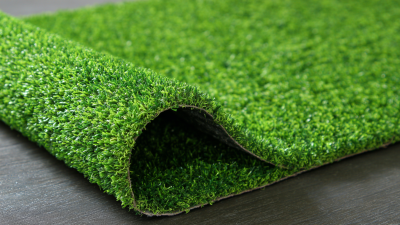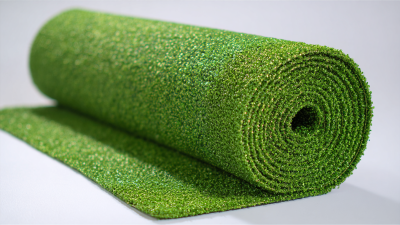5 Secrets to Choosing the Best Plastic Green Grass Mat for Your Home
In recent years, the demand for versatile outdoor solutions has surged, with the global artificial grass market projected to reach approximately $5.77 billion by 2027, reflecting a CAGR of around 15.1% from 2020 to 2027. Among the various options available, the Plastic Green Grass Mat stands out for its durability, ease of maintenance, and aesthetic appeal.

However, choosing the right mat can pose challenges, as not all products are created equal. Issues such as UV degradation, poor drainage, and environmental impact are critical considerations that homeowners must navigate. In light of these challenges, this blog aims to unveil the five secrets to selecting the best Plastic Green Grass Mat for your home, ensuring you make an informed choice that not only enhances your living space but also aligns with industry standards for quality and sustainability.
Understanding the Material: Key Features of Quality Plastic Green Grass Mats
When selecting the best plastic green grass mat for your home, understanding the key features of quality mats is essential. Look for mats that utilize high-quality plastic materials, which not only enhance the visual appeal but also ensure durability. A good mat should have UV resistance to withstand sunlight without fading, as well as water permeability to prevent stagnation and promote drainage. Additionally, check for non-toxic components, especially if the mat will be used in areas frequented by pets or children.
Another aspect to consider is the texture and thickness of the mat. Mats with a realistic feel and a well-defined blade structure not only mimic natural grass but also add depth to your space. Furthermore, opt for mats with antimicrobial properties to maintain a clean and hygienic environment. As the market offers a plethora of options, focusing on these key features will help you choose a plastic green grass mat that complements your home while ensuring long-lasting enjoyment and effortless maintenance.

Assessing Color and Texture: How to Achieve a Natural Look for Your Space
When choosing a plastic green grass mat for your home, color and texture play crucial roles in mimicking the authentic look of natural grass. Recent studies from the Turfgrass Information Center reveal that consumers often prefer turf options that feature varying shades of green and lifelike textures, as these factors greatly influence their overall satisfaction. For instance, mats that incorporate multi-density blades can provide more depth and realism, enhancing the aesthetic appeal of your space. With a market projected to reach $2.4 billion by 2025, it's clear that the demand for high-quality artificial grass continues to grow, driven by homeowners seeking low-maintenance landscaping solutions.
Investing in grass mats that well-replicate the look and feel of natural turf not only elevates the visual aspect of your environment but also creates a more inviting atmosphere. According to a survey by the Synthetic Turf Council, 87% of consumers reported enhanced enjoyment of their outdoor spaces after installing artificial grass, primarily due to its visual appeal and the variety of colors available. By focusing on a detailed assessment of color and texture, homeowners can achieve that perfect balance between aesthetics and practicality, ensuring their green areas remain vibrant and appealing throughout the year.
Evaluating Durability: Factors that Affect the Lifespan of Green Grass Mats
When selecting a plastic green grass mat for your home, evaluating its durability is crucial to ensure long-lasting use. Several factors influence the lifespan of these mats, including material quality, UV resistance, and the manufacturing process. According to a study by the Synthetic Turf Council, high-quality polyethylene and polypropylene fibers can significantly enhance durability. Mats crafted from these materials typically last between 8 to 15 years, making them a viable investment for both aesthetics and functionality.

Additionally, UV resistance is an essential factor to consider. UV exposure can lead to fading and deterioration over time, reducing the mat's visual appeal and structural integrity. A report from the American Society for Testing and Materials suggests that mats with UV-stabilized materials exhibit significantly improved longevity. Properties like weather resistance and drainage capabilities also contribute to the overall durability, ensuring the grass mats maintain their performance through varying weather conditions. By focusing on these critical aspects, consumers can confidently choose a green grass mat that withstands the test of time.
Choosing the Right Size and Shape: Tips for Perfect Fit in Your Home
When selecting the right size and shape for a plastic green grass mat in your home, it’s crucial to consider your specific space and intended use. According to a report by the American Society of Landscape Architects, over 70% of homeowners prefer low-maintenance landscaping solutions, making plastic grass mats an appealing choice. To ensure a perfect fit, start by measuring the area where you plan to install the mat. Whether you envision a cozy balcony, a spacious backyard, or even a play area for kids, understanding the dimensions can help you select the mat that complements your space seamlessly.
In addition to size, the shape of the mat can significantly influence the overall aesthetics of your area. Many manufacturers offer customized options, allowing you to choose from standard rectangles to more intricate designs that can hug curves or fit into corners. A study from the National Association of Realtors indicates that well-planned outdoor spaces can increase property value by as much as 15%. Therefore, investing time in finding the right size and shape for your green grass mat not only enhances your living environment but can also be a strategic decision for your home’s marketability.
Budgeting Smartly: Finding Affordable Yet Quality Options for Green Grass Mats
When it comes to selecting a green grass mat for your home, budgeting smartly can make all the difference. A recent industry report from Green Turf Insights revealed that homeowners often spend between $50 to $200 per mat, depending on size and quality. Finding affordable yet high-quality options can help you enhance your outdoor space without breaking the bank. Look for mats that are made from UV-resistant materials, ensuring they withstand the elements while maintaining their vibrant color over time.
Tip: Always compare prices from multiple suppliers before making a purchase. This can help you identify the best deals and potentially save up to 30%. In addition, many manufacturers offer seasonal discounts, so timing your purchase can lead to significant savings.
While exploring options, focus on mats that provide a balance between cost and durability. According to Turf & Landscape Magazine, premium artificial grass products can last upwards of 15 years, providing excellent value over time despite their higher initial cost. Investing in quality mats that are backed by warranty guarantees can further strengthen your purchase decision.
Tip: Consider purchasing in bulk if you install multiple mats. Many retailers offer discounts for larger orders, which can further optimize your budget while improving your home’s aesthetic appeal.
5 Secrets to Choosing the Best Plastic Green Grass Mat for Your Home - Budgeting Smartly: Finding Affordable Yet Quality Options for Green Grass Mats
| Feature | Importance | Price Range (per sq. ft.) | Quality Indicators |
|---|---|---|---|
| Material Type | High | $1.50 - $3.00 | Durability, UV Resistance |
| Color Fastness | Medium | $1.00 - $2.50 | Fading Resistance, Aesthetic Appeal |
| Thickness | High | $1.75 - $3.50 | Softness, Realism |
| Maintenance | Medium | $1.00 - $2.00 | Ease of Cleaning, Long-term Use |
| Eco-friendliness | Low | $2.00 - $4.00 | Recyclability, Non-toxic Materials |
Related Posts
-

Exploring the Versatility of the Best Plastic Green Grass Mat for Diverse Applications
-

Ultimate Checklist for Choosing the Perfect Imitation Grass Matting for Your Outdoor Space
-

Top Strategies for Choosing the Best Double Ribbed Floor Mat for Your Business
-

The Ultimate Guide to Choosing the Best Plastic Green Grass Mat for Your Business Needs
-

Top Strategies for Transforming Your Entrance with Extra Large Welcome Mats
-

7 Best Layered Front Door Mats to Transform Your Entryway

